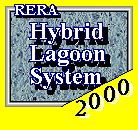
COPYRIGHTS
1999-2009 RERA
All right reserved.
Any Unauthorized
Copying
or Using Prohibited.
Preface
Table
of Contents
Foundation
Hybrid
Lagoon System
Case
Study
Applications
Proposals
27.Future
Plans. for Environmental Protection
(1):Plans for
Multifunctional Public Sewage Systems.
In Europe and the U.S., in addition to the construction of sewage systems; ordinarily human waste, household waste water and raw waste are all processed simultaneously. In Japan, such waste processing is executed in scattered locations across the country, with local autonomous organs bearing the bulk of the burden of such works. It is, however, possible to integrate and streamline the environmental and sanitation works of such local autonomous or8ans, under the supervision of which coordination of engineering would be relatively easy, and thus to reduce the capital, resources energy and manpower required of such works, for greater overall efficiency.
In the current terminal processing facilities of public sewage-systems (which employ the standard activated sludge method), there is no leeway in processing capacities, and hence no hope for expanded capacity through ?? conversion into multifunctional terminal processing facilities. However, introduction of hybrid lagoon facilities for terminal processing would result in a performance leeway suited to multifunctional public sewage system Plans, while providing the capacity for prevention of eutrophication and for high-level waste treatment. Hence it would be possible for each household to use a garbage disposer to crush all raw waste for treatment by the sewage system.

For medium- and small-size cities, rural and mountain villages, coastal villages and other small-scale communities in particular, such multifunctional public sewage facilities would eliminate the need for collection and disposal of raw waste in wintertime. Moreover, the capacity of facilities for storing sludge could be utilized to store excess sludge during the winter, to be spread in fields and pastures in the spring and autumn, as part of soil reduction processing. In this way, rational and functional planning to meed local needs is possible.
Current public sewage works require funding amounting to enormous sums representing a considerable burden not only to local autonomous organs, but to the beneficiary prefectures and the state as well. Hereafter, as plans for sewage treatment facilities shift in focus from small- and medium-size cities to rural, mountain and coastal towns and villages, we are compelled to consider the immediate efficacy of environmental and sanitation works, as well as the efficient use of society's capital.